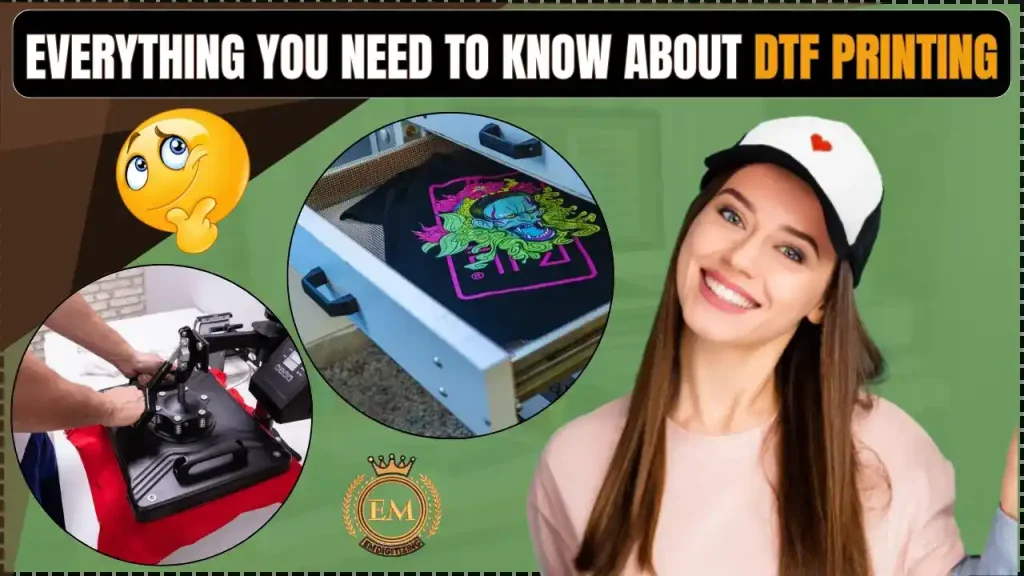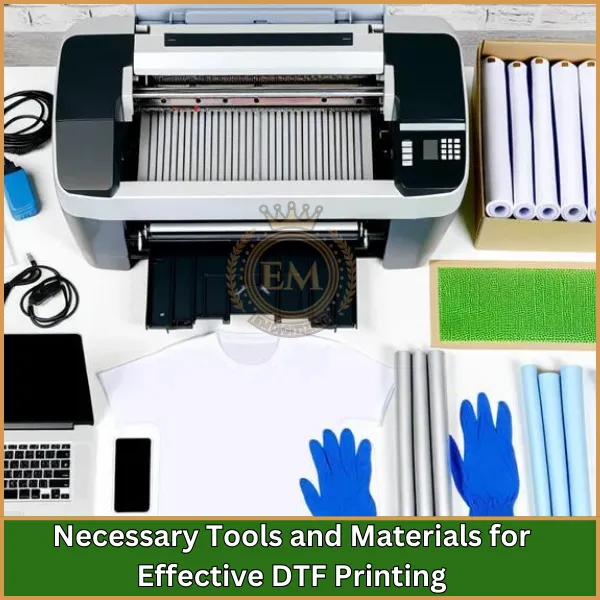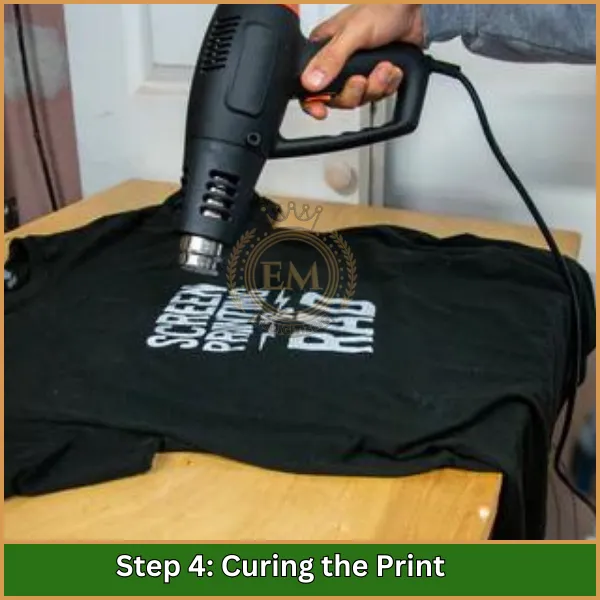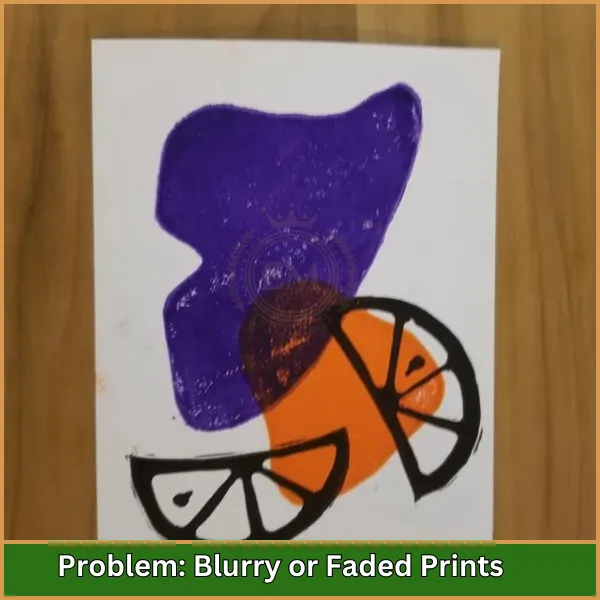Haben Sie sich jemals gefragt, wie lebendig diese sind?, Detaillierte Designs kommen auf verschiedene Stoffe? That’;Hier kommt der DTF-Druck ins Spiel.
Der Direktdruck auf Film ist eine fantastische Methode, mit der hochwertige Grafiken auf einem speziellen Film erstellt werden können, die dann nahtlos auf nahezu jede Stoffart übertragen werden kann.

Dieses Verfahren wird insbesondere wegen seiner Flexibilität geschätzt, da keine Vorbehandlung des Stoffes erforderlich ist, wodurch es für ein breites Anwendungsspektrum geeignet ist.
Alles, was Sie über DTF-Druck wissen müssen
DTF-Druck verstehen
Bei der Direct-to-Film-Technologie handelt es sich um ein Druckverfahren, bei dem digitale Bilder zunächst auf eine spezielle Folie gedruckt und anschließend auf Stoff übertragen werden. Dieser Ansatz ermöglicht eine hochauflösende und lebendige Farbwiedergabe auf einer Vielzahl von Textilmaterialien.
Wie es funktioniert
- Drucken auf Film: Designs werden digital auf ein klares gedruckt, Spezialfilm mit spezifischen Tinten, die für eine optimale Adhärenz und Haltbarkeit ausgelegt sind.
- Tintenanwendung: Die verwendete Tinte ist formuliert, um scharf zu erzeugen, lebendige Bilder, die sowohl am Film als auch an den Stoff gut haften können.
- Filmvorbereitung: Einmal gedruckt, Der Film erfährt einem Vorbereitungsprozess, bei dem ein Puderkleber angewendet wird. Dieser Klebstoff ist der Schlüssel, um den Druck auf den Stoff zu sichern.
- Übertragung auf Stoff: Der letzte Schritt besteht darin, die Tinte mit Wärme und Druck aus dem Film auf den Stoff zu übertragen, Dies aktiviert den Klebstoff und sorgt dafür, dass das Design fest an das Material hält.
Vor- und Nachteile von direkter zum Filmdruck
Es bietet eine Mischung aus hochwertigen Druckfunktionen und Vielseitigkeit, Machen Sie es zu einer bevorzugten Wahl für die Textilanpassung. Jedoch, Es kommt mit seinen eigenen Herausforderungen, die sich auf die Gesamteffizienz und Nachhaltigkeit auswirken können.
Lassen Sie uns die Vorteile und Einschränkungen dieser innovativen Druckmethode untersuchen.
Vorteile:
- Vielseitigkeit: Der DTF -Transferdruck kann auf eine Vielzahl von Stoffen angewendet werden, einschließlich synthetischer Mischungen und empfindlichen Materialien, ohne Vorbehandlung zu erfordern.
- Qualität: Die Fähigkeit zum Drucken von DTF ermöglicht eine hochauflösende Auflösung, farbenfrohe Designs, die gegen Verblassen und Knacken beständig sind, auch nach mehreren Wäschen.
- Kosteneffizient: Ideal für kleine bis mittlere Chargengrößen, Reduzierung der Einrichtungskosten und -abfälle im Vergleich zu herkömmlichen Textildruckmethoden.
- Anpassung: Diese Technologie unterstützt umfangreiche Anpassungen, Damit es perfekt für maßgeschneiderte Mode und einzigartige Werbeartikel ist.
Nachteile:
- Anfängliche Kosten: Obwohl Print DTF die laufenden Betriebskosten senkt, Die anfängliche Investition in spezialisierte Geräte und Materialien kann hoch sein.
- Komplexität: Das Verwalten des Druckprozesses erfordert technisches Wissen und Geschick, insbesondere bei der Einstellung von Druckereinstellungen und Handhabungsmaterialien.
- Umweltbelastung: Die Verwendung von Plastikfilmen und synthetischen Klebstoffen macht Nachhaltigkeitsprobleme auf, Da die Abfallentsorgung ein bedeutendes Problem ist.
- Arbeitsintensiv: Der mehrstufige Prozess, vom Drucken bis zur Wärmeübertragung, erfordert mehr manuelle Arbeit im Vergleich zu direkten Textildruckmethoden.
Notwendige Werkzeuge und Materialien für einen effektiven DTF -Druck

- DTF -Druckmaschine: Ein spezialisierter Drucker, der die einzigartigen Anforderungen des Filmdrucks bewältigen kann.
- Druckbarer Film: Spezielle Filmblätter zum Übertragen von gedruckten Designs auf Textilien.
- DTF -Shirt: Vorbereitete Hemden optimiert für den Empfang von Filmtransferred-Designs.
- DTF -Tinten: Speziell formulierte Tinten, die sowohl am Film als auch an den Stoff haften.
- Pulverkleber: Eine entscheidende Komponente, die sicherstellt.
- Hitzepresse: Ausrüstung, mit der Wärme und Druck verwendet werden, um das Design aus dem Film auf das Hemd zu übertragen.
7. Schüttelmaschine: Wird verwendet, um den Pulverkleber auf dem gedruckten Film gleichmäßig zu verteilen und zu heilen.
8. Ofen heilen: Optional, aber vorteilhaft, um die Tinte nach der Übertragung dauerhaft auf den Stoff zu setzen.
Der Schritt-für-Schritt-DTF-Druckprozess
Let’;s Brechen Sie den Prozess der Übertragung Ihres Designs mit Direkt-zu-Film-Technologie auf den Stoff auf, Schritt für Schritt.
Schritt 1: Designerstellung
Beginnen Sie damit, Ihre Grafik mithilfe von Designsoftware zu erstellen.
Schritt 2: Drucken auf Film

Laden Sie den Film in eine engagierte DTF -Drucker und wenden Sie Ihr Design direkt auf dieses spezielle Substrat an.
Schritt 3: Klebstoffpulver auftragen
Tragen Sie großzügig einen Pulverkleber über das frisch gedruckte Design auf; Dies stellt sicher, dass es sich später sicher mit dem Stoff verbinden wird.
Schritt 4: Aushärten des Drucks

Backen Sie den Film in einem Härtungsofen oder verwenden Sie eine Wärmelampe, um das Klebstoffpulver auf das Design zu trocknen, Vorbereitung auf die Übertragung.
Schritt 5: Übergang zum Stoff

Verwenden Sie eine Wärmepresse, um den Film auf Ihren Stoff aufzutragen. Die Wärme aktiviert den Klebstoff, Das Design dauerhaft an das Material verbinden.
Schritt 6: Den Film abziehen

Schritt 6: Den Film abziehen
Nach etwas abkühlen, Entfernen Sie den Film vorsichtig aus dem Stoff, das Design auf der Oberfläche intakt lassen.
Schritt 7: Endgültige Wärmeeinstellung
Optional, Möglicherweise müssen Sie dem Stoff eine letzte Presse unter einer Wärmelampe oder durch einen Tunnel geben, um das Design vollständig in den Stoff zu setzen, Verbesserung der Haltbarkeit und Waschbarkeit.
Fehlerbehebung häufiges Problem beim DTF -Druck
Hier finden Sie eine praktische Anleitung zur schnellen Lösung häufiges Problem, Stellen Sie sicher, dass Ihre Projekte jedes Mal perfekt werden.
Problem: Tinte nicht am Film festhalten
- Was geschieht: Die Tinte kann den Film nicht richtig halten.
- Schnelle Lösung: Stellen Sie sicher.
Problem: Verschwommene oder verblasste Drucke

- Was geschieht: Die Druckqualität wird beeinträchtigt, unklar oder ausgewaschen erscheinen.
- Schnelle Lösung: Verwenden Sie hochauflösende Designs, Über ausreichende Tintenversorgung suchen, und reinigen Sie die Druckerdüsen, um Blockaden zu vermeiden.
Problem: Haftpulverprobleme
- Was geschieht: Das Pulver klebt während der Wärmeübertragung nicht oder kann nicht aktiviert werden.
- Schnelle Lösung: Tragen Sie das Pulver auf, während die Tinte nass ist, und stellen Sie sicher, dass es gleichmäßig mit einem Shaker verteilt ist.
Problem: Inkonsistente Farbausgabe
- Was geschieht: Die Farben auf dem Stoff sind anders als die Designdatei.
- Schnelle Lösung: Kalibrieren Sie Ihren Drucker regelmäßig und verwenden Sie konsistent, hochwertige Tinten.
Problem: Film Peeling während der Übertragung
- Was geschieht: Der Film löst sich zu früh während der Hitzepressen vom Stoff zu früh.
- Schnelle Lösung: Stellen Sie Ihre Einstellungen für die Wärmepresse auf die richtige Temperatur und den korrekten Druck für die spezifischen Materialien ein, mit denen Sie arbeiten.
Problem: Restkleber auf Stoff
- Was geschieht: Es gibt klebrige Rückstände im Design, Beeinflussung des Stoffgefühls und des Komforts.
- Schnelle Lösung: Verwenden Sie weniger Haftpulver und stellen Sie sicher, dass es vor dem Drücken vollständig geheilt ist, um zu vermeiden.
Vergleich des DTF -Transferdrucks mit anderen Druckmethoden
Es ist zu einer herausragenden Wahl für seine Vielseitigkeit und Qualität geworden, Aber wie stapelt es sich gegen andere Drucktechniken??
Vergleichen wir es mit zwei gängigen Methoden: DTG (Direkt zum Kleidungsstück) Druck und traditionell Siebdruck.
Dtf vs. DTG -Druck
- Methode: DTF überträgt Designs aus dem Film; DTG -Drucke direkt auf Stoff drucken.
- Stoffkompatibilität: DTF arbeitet an vielen Stoffen, DTG am besten auf Baumwolle.
- Farblebendigkeit: Beide bieten lebendige Farben an; DTF hat eine leicht erhöhte Textur.
- Kosteneffizienz: DTF ist besser für kleine bis mittlere Läufe.
- Geschwindigkeit: DTF ist normalerweise schneller im Setup und druckt mehrere Elemente.
Dtf vs. Siebdruck
- Methode: DTF verwendet Wärmeübertragung; Siebdruck verwendet Tinte durch Bildschirme.
- Stoffkompatibilität: Screen -Druck zeichnet sich auf weitere Stoffe aus, einschließlich schwerer Materialien.
- Farblebendigkeit: Der Bildschirmdruck ist sehr lebendig mit einem strukturierteren Finish.
- Kosteneffizienz: Der Siebdruck ist für große Bestellungen wirtschaftlicher.
- Geschwindigkeit: Der Bildschirmdruck ist für große Chargen nach dem Einsetzen schneller.
Fazit
DTF -Druck ist eine großartige Möglichkeit, Designs auf Kleidung und andere Gegenstände zu setzen. Es funktioniert gut mit vielen Arten von Stoffen und ist gut, um kleine bis mittlere Chargen schnell und einfach zu machen. DTF erleichtert es einfach, benutzerdefinierte Designs zu erstellen, wann immer Sie sie benötigen.
Um Ihre DTF -Projekte noch besser zu machen, Versuchen Sie, Profi zu verwenden Dienstleistungen im Bereich Vektorkunst. Bei EMdigitalisieren, Wir bieten qualitativ hochwertige, Detaillierte Designs perfekt für den DTF -Druck. Unsere Designs helfen dabei, sicherzustellen, dass jeder Druck klar und farbenfroh aussieht.
Im Augenblick, Wir bieten eine an 50% Rabatt für neue Kunden. Starten Sie Ihren DTF -Druck mit Emdigitisierung und verwandeln Sie Ihre Ideen in schöne Drucke, die jeder bemerken wird. Let us help you make designs that really grab people’;s Aufmerksamkeit.
Häufig gestellte Fragen
Ja, Der DTF -Druck ist langlebig und dauert viele Wäsche, ohne zu verblassen oder zu schälen, Machen Sie es zu einer zuverlässigen Option für den Stoffdruck.
Es kommt darauf an. DTF arbeitet an weiteren Stoffen, einschließlich Baumwolle, Während Sublimation für Polyester am besten geeignet ist und einen reibungslosen bietet, Farbstoff-ähnliches Finish.
Die Hauptnachteile sind die hohen Anfangskosten und laufenden Kosten für spezielle Tinten und Filme, Außerdem kann der Prozess für Anfänger komplex sein.
Für kleine bis mittlere Bestellungen, DTF ist aufgrund niedrigerer Einrichtungskosten kostengünstiger. Für große Bände, Siebdruck kann billiger sein.
DTG -Drucke können mit häufigem Waschen verblassen, Aber die richtige Pflege kann sie für eine lange Zeit lebendig halten.
